|
|
Cygnus ( Latin: swan) is a northern constellation. It was one of Ptolemy's 48 constellations, and is also one of the 88 modern constellations. Because of the pattern of its main stars, it is sometimes known as the Northern Cross (in contrast to the Southern Cross). It is said to resemble a swan, the bird extending over the Milky Way, appearing to fly south. Notable deep sky objects Several star clusters and nebulae are found in Cygnus due to its position on the Milky Way. The North America Nebula (NGC 7000) is found a bit to the east of Deneb. Its resemblance to the continent is best appreciated in photographs. The Pelican Nebula (IC 5070) is nearby. To the south of Epsilon Cygni is the Veil Nebula (NGC 6960, 6962, 6979, 6992, and 6995) which is an ancient supernova remnant covering approximately 3 degrees of the sky. Also of note is the Crescent Nebula (NGC 6888), located between Gamma and Eta Cygni, which was formed by the Wolf-Rayet star HD 192163. More supernovae have been seen in the Fireworks Galaxy (NGC 6946) than in any other galaxy. History and mythology The constellation bears a resemblance to a wide winged, long necked bird, in graceful flight [1]. In Greek mythology, the constellation represents several different legendary swans. Zeus disguised himself as a swan to seduce Leda, who gave birth to the Gemini, Helen of Troy, and Clytemnestra. Orpheus was transformed into a swan after his murder, and was said to have been placed in the sky next to his lyre (Lyra). Finally, it is said that a king named Cycnus was a relative or lover of the ill-fated Phaëthon. The son of Apollo, Phaethon tricked his father into allowing him to ride the chariot of the Sun, but lost control and was struck down by Zeus. Grief-stricken after Phaëthon's death, and determined to give his remains a proper burial, Cycnus dove to the bottom of the river Eridanus to find him. He dove so many times into the river that he was transformed into the swan Cygnus, and is visible in the sky today. Cygnus, together with other constellations in the Zodiac sign of Sagittarius (specifically Lyra and Aquila, together with Sagittarius itself), may be a significant part of the origin of the myth of the Stymphalian Birds, one of The Twelve Labours of Heracles. In Chinese mythology, the constellation Cygnus is the site of the once-a-year magpie bridge (鹊桥, Que Qiao) which connects the lovers Niu Lang and Zhi Nu (see Qi Xi). In Ovid's Metamorphoses, there are three people named Cygnus, all of whom are transformed into swans. The first is the relative of Phaethon mentioned above, who is the son of Sthenelus and king of Liguria. The second is a boy from Tempe, to whom Phyllius gives several tamed animals as gifts. When Phyllius refuses to give Cygnus a tamed bull that the boy demands, Cygnus throws himself off a cliff in a fit of spite. Instead of falling to his death, Cygnus is transformed into a swan and flies away. The third person named Cygnus is a son of Neptune. He is a warrior in the Trojan War who is invulnerable to all stabbing weapons, much to the frustration of his enemy, Achilles. Achilles finally kills him by smashing his face in with his shield, but Neptune saves Cygnus by transforming him into a swan. References * Ian Ridpath and Wil Tirion (2007). Stars and Planets Guide Links
Retrieved from "http://en.wikipedia.org/"
|
|
||||||||||||||||||||||||||||||||||||||||||||||||||||


